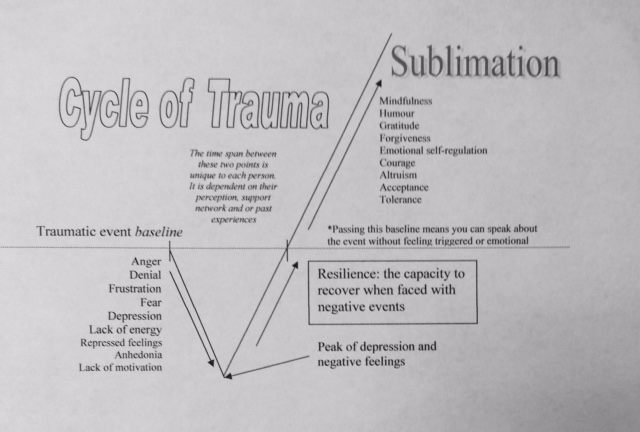Cycle of Trauma
Individually we are designed and equipped to handle trauma because it is almost inescapable during a lifetime. Traumatic experiences resonate differently with each individual because we create our own perception of events. For example, for one family the loss of a loved one can create pain, suffering and depression whereas for another it may give peace to know their loved one has gone to Heaven. Perception of events is a very important factor when assessing the severity of traumatic exposure. Duration, frequency, or length of exposure is another important factor to consider while treating trauma. If a client has been repeatedly beaten or sexually abused for months as opposed to an isolated incident, this will significantly impact their perception of events. Often trauma experienced by one person can also leave a mark on the entire family. Those who experienced a sudden jolt of trauma may appear to go from a fun loving, caring and funny extrovert, to a sad, angry and dark introvert with the blink of an eye. Aside from the person who directly experienced the trauma, a spouse, parents, siblings or close friends may also feel the subsequent impact through a change in their loved ones character or behaviour.
Trauma is one of my areas of specialization and I usually start with a full assessment when someone comes looking for treatment. I use the Trauma Symptom Inventory which generally helps me fine tune my focus anywhere from hyperarousal to avoidance to dissociation and so on. Trauma may impact someone in such a variety of ways that having a specific focus of treatment is beneficial and highly recommended. This assessment also tests for measures of suicidal ideation which I believe to be imperative for trauma survivors. One measure that many of my clients present with is an elevation in the category of Tension Reduction Behaviour (TRB). This is also an important area to focus on because most people tend to develop their own coping techniques following a traumatic event, and often may resort to poor choices. For example some people experience very low levels of dopamine and serotonin shortly after their traumatic experience, so in order to rectify this feeling, they end up gambling in a casino for hours or turn to drug use. Each person has different forms of TRB which I thoroughly explore and help to re-evaluate if necessary.
The diagram below of traumatic exposure explains the process of trauma from start to finish. The initial stages may include shock, denial, anger and frustration, fear, depression, health issues, repression of feelings, anhedonia etc… The diagram suggests some of the possible symptoms associated with trauma but not all. Following these reactionary negative events, we see a peak of depressive symptoms. This is where we begin to shift perspective and start to re-balance. This may occur from intense therapeutic intervention or a shift in awareness after the ‘trauma dust has settled’. Once this occurs, we start a period of resiliency where we build ourselves back up through a transition of tolerance, forgiveness, humour, mindfulness, increased empathy, increased self regulation etc… and finally achieve a phase called sublimation. Ideally, each person reaches this phase following a traumatic event. This is where our focus shifts towards ways we can use our experience of this traumatic event and turn it into something positive. Ie. Raising awareness, charity fundraisers, public speaking, helping others etc. The time frame in which this transition occurs from start to finish may take a person up to two years or more to complete.
The body and mind is extremely resilient by nature and we are never faced with more than we can handle. Ultimately traumatic events, as difficult as they may be, tend to shift our awareness and broaden our perspectives. As the old saying goes, “the harder you fall, the higher you bounce.” Although trauma may be taxing our mind and body and seemingly impossible to get through, we somehow end up on the other side of the finish line in better condition than we were to begin with.



Add Comment